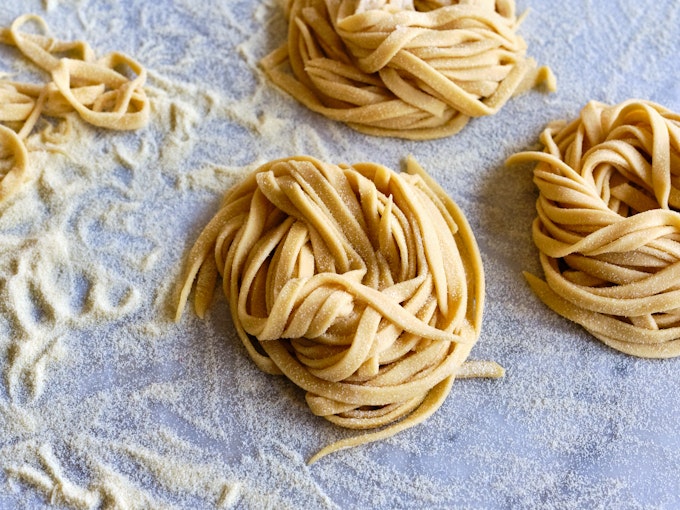Homemade Pasta
5.0
(10)
Your folders
Your folders
Prep Time: 45 minutes
Cook Time: 1 minutes
Total: 46 minutes
Servings: 4
Cost: $7.26 /serving
Author : Heidi Swanson

Ingredients
Export 3 ingredients for grocery delivery
Instructions
Step 1
Start by making a mound of the flour directly on the countertop. Make a deep crater in the top and add the eggs, olive oil, and salt. Use a fork to break up the eggs without breaking through the walls of your mound. You want to try to keep the eggs contained, but don’t worry if they break through - use a spatula or bench scraper to scoop them back in. Work more and more flour into the eggs a bit at a time. Drizzle 2 tablespoons of cold water across the mixture and keep mixing until you’ve got a dough coming together. If you’re exclusively using all-purpose flour, you might not need more water. Some of the other flours are a bit thirstier, you can drizzle a bit more at time as you go if you feel like your dough is too dry. It should look like the pictures up above, you want to avoid having a wet dough. I’ve found that a spray bottle is my favorite way to add water to pasta dough without adding too much. Use your hands to bring the dough together into a ball and knead for 7-10 minutes, until the dough is silky smooth and elastic.
Step 2
Form the dough into a ball and place in a plastic bag, alternately, wrap in plastic wrap. Allow to rest for 30 minutes at room temperature. Use Immediately, or refrigerate for up to a day. You might be able to get away with two days, but the dough will start to discolor.
Step 3
At this point either roll the pasta out thinly with a rolling pin or use a pasta maker (see notes and photos above). If your dough was refrigerated, bring it to room temperature before rolling out. After cutting the pasta into your desired shape you can cook the pasta immediately, dry it, refrigerate it, or freeze it at this point (see above).
Step 4
When you’re ready to cook the pasta do it in a large pot of well-salted water. Depending on the thickness and shape of your pasta, this might just take a minute or so. Reserve a cup or two of the pasta water (in case you want to use it for a sauce), drain the pasta, and use immediately.
Step 5
Add the flour, eggs, olive oil, salt and 2 tablespoons of water to the bowl of a stand mixer. Use the dough hook to knead on medium speed for 6-7 minutes. You’ll likely need to add more water, a small splash at a time, just until the dough comes together, you want to avoid an over-wet or sticky dough. See the pictures up above. Mix until the dough looks silky, elastic, and smooth.
Step 6
Form the dough into a ball and place in a plastic bag, alternately, wrap in plastic wrap. Allow to rest for 30 minutes at room temperature. Use Immediately, or refrigerate for up to a day. You might be able to get away with two days, but the dough will start to discolor.
Step 7
Roll out your pasta dough (see above). I typically choose 3 or 4 on the Atlas for fettuccine noodles, or the equivalent on the Kitchen Aid attachment. You'll need a well-floured surface if you're rolling the dough out by hand, and you'll want to keep the pasta nicely floured as well, so it doesn't stick to itself. To cut the dough into fettuccine by hand, loosely fold/roll the dough into a cylinder, and cut with a sharp knife. Alternately, you can run the dough though the fettuccine cutter on your pasta machine.
Step 8
When you’re ready to cook the pasta do it in a large pot of well-salted water. Depending on the thickness and shape of your pasta, this might just take a minute or so. Reserve a cup or two of the pasta water (in case you want to use it for a sauce), drain the pasta, and use immediately.